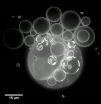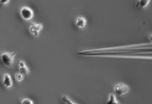(Press-News.org) In a paper published today in Nature Nanotechnology, an international group of scientists announced the most significant breakthrough in a decade toward developing DNA-based electrical circuits.
The central technological revolution of the 20th century was the development of computers, leading to the communication and Internet era. The main measure of this evolution is miniaturization: making our machines smaller. A computer with the memory of the average laptop today was the size of a tennis court in the 1970s. Yet while scientists made great strides in reducing of the size of individual computer components through microelectronics, they have been less successful at reducing the distance between transistors, the main element of our computers. These spaces between transistors have been much more challenging and extremely expensive to miniaturize – an obstacle that limits the future development of computers.
Molecular electronics, which uses molecules as building blocks for the fabrication of electronic components, was seen as the ultimate solution to the miniaturization challenge. However, to date, no one has actually been able to make complex electrical circuits using molecules. The only known molecules that can be pre-designed to self-assemble into complex miniature circuits, which could in turn be used in computers, are DNA molecules. Nevertheless, so far no one has been able to demonstrate reliably and quantitatively the flow of electrical current through long DNA molecules.
Now, an international group led by Prof. Danny Porath, the Etta and Paul Schankerman Professor in Molecular Biomedicine at the Hebrew University of Jerusalem, reports reproducible and quantitative measurements of electricity flow through long molecules made of four DNA strands, signaling a significant breakthrough towards the development of DNA-based electrical circuits. The research, which could re-ignite interest in the use of DNA-based wires and devices in the development of programmable circuits, appears in the prestigious journal Nature Nanotechnology under the title " Long-range charge transport in single G-quadruplex DNA molecules."
Prof. Porath is affiliated with the Hebrew University's Institute of Chemistry and its Center for Nanoscience and Nanotechnology. The molecules were produced by the group of Alexander Kotlyar from Tel Aviv University, who has been collaborating with Porath for 15 years. The measurements were performed mainly by Gideon Livshits, a PhD student in the Porath group, who carried the project forward with great creativity, initiative and determination. The research was carried out in collaboration with groups from Denmark, Spain, US, Italy and Cyprus.
According to Prof. Porath, "This research paves the way for implementing DNA-based programmable circuits for molecular electronics, a new generation of computer circuits that can be more sophisticated, cheaper and simpler to make."
INFORMATION:
The research was supported by the European Commission, the European Science Foundation, the Israel Science Foundation, the Binational Science Foundation, the Minerva Center for Bio-Hybrid complex systems, the Institute for Advanced Studies of the Hebrew University of Jerusalem, the Italian Institute of Technology project MOPROSURF, the Fondazione Cassa di Risparmio di Modena, the Office of Naval Research, and the National Science Foundation.
Breakthrough in molecular electronics paves the way for DNA-based computer circuits in the future
DNA-based programmable circuits could be more sophisticated, cheaper and simpler to make
2014-10-27
ELSE PRESS RELEASES FROM THIS DATE:
Cell membranes self-assemble
2014-10-27
A self-driven reaction can assemble phospholipid membranes like those that enclose cells, a team of chemists at the University of California, San Diego, reports in Angewandte Chemie.
All living cells use membranes to define physical boundaries and control the movement of biomolecules, and movement of molecules through membranes is a primary means of sending signals to and from cells.
Neal Devaraj, a chemistry and biochemistry professor at UC San Diego, leads a research team that develops and explores new reactions that can trigger the formation of membranes, particularly ...
First time-lapse images of exploding fireball from a 'nova' star
2014-10-27
Astronomers at the University of Sydney are part of a team that has taken images of the thermonuclear fireball from a 'nova star' for the first time tracking the explosion as it expands.
The research is published in the journal Nature today.
The eruption occurred last year in the constellation of Delphinus (the Dolphin).
Professor Peter Tuthill, from the University's Sydney Institute for Astronomy and co-author on the paper says astronomers are excited about the achievement:
"Although novae often play second fiddle in the popular imagination to their more famous ...
Tremendously bright pulsar may be 1 of many
2014-10-27
Recently, a team of astronomers reported discovering a pulsating star that appears to shine with the energy of 10 million suns. The find, which was announced in Nature, is the brightest pulsar – a type of rotating neutron star that emits a bright beam of energy that regularly sweeps past Earth like a lighthouse beam – ever seen. But what are the odds finding another one?
According to one of the paper's authors, chances are good now that they know what to look for.
Professor Deepto Chakrabarty of the Kavli Institute for Astrophysics and Space Research at ...
Emergent behavior lets bubbles 'sense' environment
2014-10-27
VIDEO:
A collection of artificial lipid bubbles cycle through changes in their membranes as the surrounding environment changes. As the osmotic potential changes, different lipids in the membranes form patchy domains...
Click here for more information.
Tiny, soapy bubbles can reorganize their membranes to let material flow in and out in response to the surrounding environment, according to new work carried out in an international collaboration by biomedical engineers at the ...
One drop will do: UBC researchers develop simple new test for vitamin B12 deficiency
2014-10-27
Researchers at the University of British Columbia have developed a novel method to test for vitamin B12 deficiency that is sensitive enough to work on anyone, including newborn babies and large swaths of the general population.
Vitamin B12 deficiency can be tested with a single drop of blood collected from a finger prick, then blotted and dried overnight on a card consisting of filter paper. The UBC study made dried blood spot card analysis sensitive enough to measure the amount of methylmalonic acid (MMA), an indicator of a person's B12 level.
"This minimally invasive ...
International research group publishes updated criteria for diagnosing multiple myeloma
2014-10-27
ROCHESTER, Minn. –The International Myeloma Working Group (IMWG) today announced that it has updated the criteria for diagnosing multiple myeloma. A paper outlining the new criteria was published in the journal Lancet Oncology. Multiple myeloma is a blood cancer that forms in a type of white blood cell called a plasma cell.
"Our group, which includes more than 180 myeloma researchers worldwide, has updated the definition of multiple myeloma for diagnostic purposes to include validated biomarkers in addition to the current clinical symptoms used for diagnosis which ...
Diabetes patients report better outcomes with improved physician accessibility
2014-10-27
LOS ANGELES — A new model of delivering primary care studied by Keck Medicine of the University of Southern California (USC) researchers has the potential to improve the health of patients with type 2 diabetes.
The model encourages doctors to be more of a "medical home" for their patients by being accessible to patients in person and by phone, developing good ongoing relationships with their patients, and being more proactive in helping coordinate care for patients with difficult health problems.
Gregory Stevens, Ph.D., associate professor of family medicine ...
Clinical results indicate vaccine candidate highly efficacious against bacterial diarrhea
2014-10-27
Washington, DC, October 27, 2014—New results from a safety and immunogenicity study, which included a challenge phase to test efficacy, indicate that a live attenuated enterotoxigenic Escherichia coli (ETEC) vaccine candidate, given in combination with a novel adjuvant, provided significant protection against disease. This represents the first efficacy data for this vaccine/adjuvant combination, which was 58.5 percent efficacious in protecting against diarrhea of any severity using a highly rigorous ETEC human challenge model. The vaccine/adjuvant combination was ...
How cells know which way to go
2014-10-27
VIDEO:
In this video, lab-grown human leukemia cells move toward a pipette tip holding an attractive chemical.
Click here for more information.
Amoebas aren't the only cells that crawl: Movement is crucial to development, wound healing and immune response in animals, not to mention cancer metastasis. In two new studies from Johns Hopkins, researchers answer long-standing questions about how complex cells sense the chemical trails that show them where to go — and the ...
The Ebola epidemic: Is there a way out?
2014-10-27
Berlin, 27 October 2014. Not everyone who contracts the Ebola virus dies, the survival rate is around 30% suggesting that some kind of immunity to the disease is possible. Experimental treatments and vaccines against Ebola exist but have not yet been tested in large groups for safety and efficacy (phase 2 trials).
The International Union of Immunology Societies (IUIS) published a statement today in its official journal, Frontiers in Immunology calling for urgent and adequate funding of vaccine candidates in clinical trials and speedy implementation of immunisation in ...
LAST 30 PRESS RELEASES:
Scientists to ‘spy’ on cancer- immune cell interactions using quantum technology breakthrough
Tech savvy users have most digital concerns
Making lighter work of calculating fluid and heat flow
Normalizing blood sugar can halve heart attack risk
Lowering blood sugar cuts heart attack risk in people with prediabetes
Study links genetic variants to risk of blinding eye disease in premature infants
Non-opioid ‘pain sponge’ therapy halts cartilage degeneration and relieves chronic pain
AI can pick up cultural values by mimicking how kids learn
China’s ecological redlines offer fast track to 30 x 30 global conservation goal
Invisible indoor threats: emerging household contaminants and their growing risks to human health
Adding antibody treatment to chemo boosts outcomes for children with rare cancer
Germline pathogenic variants among women without a history of breast cancer
Tanning beds triple melanoma risk, potentially causing broad DNA damage
Unique bond identified as key to viral infection speed
Indoor tanning makes youthful skin much older on a genetic level
Mouse model sheds new light on the causes and potential solutions to human GI problems linked to muscular dystrophy
The Journal of Nuclear Medicine ahead-of-print tip sheet: December 12, 2025
Smarter tools for peering into the microscopic world
Applications open for funding to conduct research in the Kinsey Institute archives
Global measure underestimates the severity of food insecurity
Child survivors of critical illness are missing out on timely follow up care
Risk-based vs annual breast cancer screening / the WISDOM randomized clinical trial
University of Toronto launches Electric Vehicle Innovation Ontario to accelerate advanced EV technologies and build Canada’s innovation advantage
Early relapse predicts poor outcomes in aggressive blood cancer
American College of Lifestyle Medicine applauds two CMS models aligned with lifestyle medicine practice and reimbursement
Clinical trial finds cannabis use not a barrier to quitting nicotine vaping
Supplemental nutrition assistance program policies and food insecurity
Switching immune cells to “night mode” could limit damage after a heart attack, study suggests
URI-based Global RIghts Project report spotlights continued troubling trends in worldwide inhumane treatment
Neutrophils are less aggressive at night, explaining why nighttime heart attacks cause less damage than daytime events
[Press-News.org] Breakthrough in molecular electronics paves the way for DNA-based computer circuits in the futureDNA-based programmable circuits could be more sophisticated, cheaper and simpler to make


